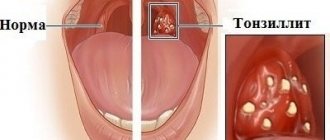Laryngeal papilloma. Symptoms
Symptomatically, laryngeal papillomatosis can be represented by hoarseness, chronic cough, difficulty breathing, difficulty swallowing, recurring respiratory infections, and growth retardation in children. The presence of certain symptoms depends on the location of the papillomas. In children, the symptoms are more pronounced, since they have a significantly faster growth of papillomas, unlike adults. This can lead to situations in which emergency intervention is required for life-saving reasons, despite the histologically benign course of the disease. The prognosis is more favorable in terms of remission if the disease manifests itself in adulthood. The exception is the presence of HPV type 11 and the duration of the disease for more than 10 years.
How to diagnose?
A person who feels a cyst should go to the doctor. And the first question he will have to answer is when exactly he first discovered the formation. It is important. “First of all, a person looks into his own throat, takes a flashlight and tries to see if there is something. As a rule, this occurs against the background of a number of symptoms,” notes the ENT specialist.
Among the symptoms that may be accompanied by a cyst in the throat, Vladimir Zaitsev names the following conditions:
- foreign body sensation;
- dry throat;
- sensation of a lump.
Sometimes there is a situation when in a normal state everything is fine - there are no surprises, but during, for example, a swallow, a problem is very clearly felt.
Article on the topic
Cancer is not rock. How to identify cancer at an early stage It is worth understanding that a cyst or papilloma can be located deep in the throat - so that a person himself will not see it. In such a situation, only a doctor can do this. “A correctly performed examination will look like this: first the doctor will conduct a visual examination, collect complaints, and then perform an endoscopy. With the help of the device, he will be able to fully examine the formation - where it is located, size and affiliation,” says Vladimir Zaitsev.
Causes of laryngeal papilloma. Who is at risk?
The etiological factor is human papillomavirus (HPV), in most cases types 6 and 11. The latter leads to a more severe course of the disease. Less commonly, laryngeal papillomatosis can be caused by HPV types 16 and 18, which are viruses with a high risk of developing malignant neoplasms. However, the presence of HPV in the human respiratory tract does not always lead to papillomatosis. Determining factors can be immunodeficiency states and chronic infections. Concomitant infection with the herpes simplex virus and the Epstein-Barr virus contribute to a more aggressive course of the disease.
Laser removal of papilloma in the throat. Progress in medicine helps.
The main thing is to keep up with it and take advantage of all the new opportunities. In the treatment of papillomatosis, these include the use of CO2 laser, narrow-spectrum endoscopy and certain antiviral drugs. But there is one prerequisite to achieve the best result - everything must be performed by a highly qualified surgeon with extensive experience in treating laryngeal papillomatosis. This is extremely important to understand.
Papillomatosis is characterized by the formation of exophytic growths that affect the mucous membrane of various parts of the larynx and underlying parts of the respiratory tract.
More than 10 years without recurrence of papillomatosis.
All patients treated by Professor Roberto Pujedo have not experienced a relapse of the disease for more than ten years .
“A comprehensive approach is a key success factor. Starting with detailed diagnostics using cutting-edge technologies, ending with careful monitoring in the postoperative period.”
Along with the expertly performed complete removal of papillomas, Professor Roberto Pujedo carries out targeted administration of antiviral drugs into the mucous membrane of the affected areas of the larynx.
Reliable source:
Enhanced contact endoscopy (ECE) in head and neck surgery
Many patients talk about dozens of surgeries in their history and endless relapses. It seems that it is impossible to cope with this disease. Each time the voice becomes worse, numerous scars form in the larynx.
Now this is history!
Symptoms
How does throat cancer start? At the beginning of the disease, there are no symptoms of the disease. Throat cancer manifests itself with common symptoms characteristic of oncology:
- A slight increase in temperature (up to 37.5°C);
- Drowsiness and constant fatigue;
- Weakness and general malaise;
- Fatigue quickly.
When the tumor of the throat and pharynx increases in size, symptoms characteristic of a malignant neoplasm appear. Signs of laryngeal cancer depend on the location of the pathological process.
What are the symptoms of throat cancer located in the vestibular part of the larynx? Initially, the patient does not show any complaints. As the laryngeal tumor progresses, the symptoms become specific. There is pain and discomfort when swallowing. This occurs due to deformation of the epiglottis and damage to the nerve endings. The epiglottis is deformed and does not completely close the entrance to the larynx. For this reason, the patient constantly chokes.
Malignant neoplasms of the vestibular region are aggressive. The tumor quickly spreads to surrounding organs and metastasizes to the lymph nodes of the neck. The reason for this is the well-developed lymphatic system of the vestibular region and its numerous connections with the lymphatic vessels of the pharynx.
What are the signs of throat cancer localized in the supraglottic part of the larynx? At the initial stage of development of cancer of the supraglottic larynx, there are no symptoms or manifestations of the disease. As the size of the tumor increases, the patient's voice changes and discomfort is felt when swallowing. When the tumor grows into the surrounding tissues, acute pain appears during swallowing, which radiates to the ear and hoarseness of the voice.
What are the symptoms of throat cancer when the pathological process is localized on the vocal cords? With this location of the malignant tumor, pain appears even with a small size of the tumor. The patient experiences the following symptoms of throat and larynx cancer:
- The voice is impaired;
- Hoarseness and hoarseness appear;
- Sonority and melody are lost.
The patient begins to get tired even after a short conversation. If the tumor grows into the lumen of the glottis, the patient's breathing becomes impaired.
Cancer of the middle part of the larynx has the most favorable course. The lack of lymphatic vessels in this area explains the rare metastasis of malignant tumors. Hoarseness, which occurs even with small tumor sizes, forces a person to consult a doctor soon after the onset of this symptom.
How does throat cancer manifest if the tumor is located in the subglottic region of the larynx? Malignant tumors in this area also have a number of features:
- Endophytic growth form;
- Resistance to ionizing radiation;
- Metastasis mainly to the preglottic and pretracheal lymph nodes.
There are no early symptoms of the disease. The first sign of laryngeal cancer is a dry, paroxysmal cough. After the tumor grows into the vocal cords, the patient's voice is impaired. As the pathological process progresses and the malignant tumor grows into the lumen of the larynx, the patient develops symptoms of throat and larynx cancer, such as breathing problems with attacks of suffocation. If the disease enters the final stage and begins to destroy surrounding tissues, putrid breath and a cough with blood clots appear.
How do you know if you have throat cancer? Malignant neoplasms of the pharynx and larynx do not have specific symptoms. Doctors at the Yusupov Hospital establish an accurate diagnosis after examining and instrumental examination of the patient. If there is throat cancer, symptoms of the disease, doctors take photos during the examination. It can be sent to a partner clinic and advice from other specialists can be obtained.
Stages of tumor formation in the throat
There are 4 stages of laryngeal cancer:
- The first stage - the neoplasm is localized in the mucous membrane. The tumor is limited and does not occupy the entire larynx. The neoplasm does not affect nearby tissues and organs and does not metastasize;
- The second stage - a tumor or ulcer occupies one entire section of the larynx, but does not extend beyond it. The mobility of the larynx is preserved. Metastases are not detected in regional lymph nodes;
- The third stage is divided into 3A and 3B. At stage 3a, the tumor spreads to adjacent parts of the larynx, causes immobility of the corresponding half of the organ, or, although it is limited to one floor of the larynx, it is accompanied by immobility of the ligament or arytenoid cartilage, or ligament. Stage 3B throat cancer is characterized by tumor spread to organs adjacent to the larynx and regional lymph nodes;
- Stage four – an extensive tumor occupies most of the larynx, infiltrates neighboring tissues, there are fixed metastases in the lymph nodes of the neck, or a neoplasm of any size with distant metastases.
With stage 1 throat cancer, patients develop a constant cough and the timbre of their voice changes. After properly selected treatment, tumor recurrence does not occur within five years in 80% of patients. Stage 2 of throat cancer is manifested by disruption of the vocal folds and breathing problems. The patient's voice becomes hoarse and there is pain when swallowing. The five-year survival rate is 70%.
Stage 3 throat cancer is manifested by a complete absence of voice due to damage to the vocal cords. With stage 3 laryngeal cancer, the life expectancy of 60% of patients is 5 years.
The diagnosis of stage 4 laryngeal cancer is manifested by symptoms of damage to the larynx and internal organs in which the metastases are localized (esophagus, lungs and bronchi, digestive organs). Metastases to the liver and brain are less commonly detected. Is it possible to cure stage 4 laryngeal cancer? With stage 4 throat cancer, life expectancy is short. Five-year survival rate is less than 25%.
Possible methods of treating laryngeal papillomas.
Careful removal of papillomatous growths under a microscope and using a CO2 laser is fundamental. However, removal must be carried out exclusively within the mucous membrane, where the formations are located. Moreover, the normal mucosa must be preserved. The surgeon must be experienced and thoroughly understand the mechanism of papillomas formation. Otherwise, gross surgical intervention leads to loss of voice, severe scarring, and stenosis.
Studies have shown that intraepithelial administration of antiviral drugs can reduce the number of operations to remove papillomas, leading to partial regression of the growth of formations. Also, local administration of an antiviral drug avoids systemic toxicity.
The mechanism of action of interferons in laryngeal papillomatosis is unknown, however, they are often used as an additional treatment. Interferons are naturally produced by white blood cells in response to various stimuli, including viral infection. They bind to specific cell membrane receptors and change metabolism, providing antiviral, antiproliferative and immunomodulatory effects. The clinical effectiveness of interferons in the treatment of laryngeal papillomatosis is ambiguous and controversial. The main limitation for their use are side effects when administered intravenously: increased levels of transaminases in the blood, leukopenia, thrombocytopenia. Patients may experience weakness, nausea, fever, arthralgia, and headache.
Indol-3-carbinol can be extracted from cruciferous plants (broccoli, cabbage). In vitro studies have shown promising results on the growth of papillomas by influencing estrogen metabolism. When administered orally to a small number of pediatric patients, no adverse effects were observed. However, the clinical effectiveness of this drug remains in doubt.
Measles, mumps, rubella (MMR) vaccine . A prospective randomized controlled trial showed that intraepithelial administration of MMR vaccine could prolong the period of remission after surgical treatment.
HspE7. A new vaccine targeting oncogenic HPV types has also been used to successfully control relapses of laryngeal papillomatosis.
The presence of GERD was associated with an increased likelihood of complications. The irritating effect on the mucous membrane can act as a trigger for the proliferation and spread of papillomatous growths. Studies have shown that the use of drugs to treat GERD promotes better control of laryngeal papillomatosis and prolongs remission.
According to a Cochrane review, photodynamic therapy has not been shown to be effective in the treatment of laryngeal papillomatosis.
Watch the video BEFORE/AFTER surgery to remove laryngeal papillomatosis
Relapse-free postoperative follow-up for a year. Endoscopy in NBI mode. Credit: Professor Roberto Pujedo.
Look at the photos BEFORE/AFTER the operation by Prof. Roberto Pugedu
Photos “before” and “after” surgery to remove laryngeal papillomatosis. Credit: Professor Roberto Pujedo.
Move the slider to see the difference.
Possible complications
As already mentioned, the presence of clusters of caseous masses is not as harmless as it might seem at first glance. The danger of this condition is that pathogenic microflora from the lacunae of the tonsils can spread to other organs beyond the tonsils and provoke various kinds of complications:
- Peritonsillar abscess of tissue around the tonsils. A severe inflammatory process starts in the tissues around the tonsils. A patient with this condition experiences a sore throat. He can't help but feel like there's a foreign object stuck in his throat. There are difficulties with swallowing and wide opening of the mouth (trismus of the masticatory muscles). Periodically, the patient has a fever, and other unpleasant symptoms of intoxication of the body appear. In this case, only opening the peritonsillar abscess, sometimes with the simultaneous removal of the tonsils (abscessonsillectomy), will help improve the patient's condition.
- Cervical phlegmon is an infection of the tissue of the neck. The patient experiences severe pain at the site of inflammation, and the body temperature rises to 40°C. The danger is that a purulent infection can enter the blood and cause sepsis and purulent damage to other organs. The abscess can also descend into the mediastinum - the case where our heart is located. This inflammation is called mediastinitis. This is a disease with an extremely high mortality rate!
- Sepsis (blood poisoning), caused by infection in the blood. This condition is extremely dangerous for humans and requires urgent hospitalization.
- Kidney diseases.
- Joint diseases.
- Heart diseases.










